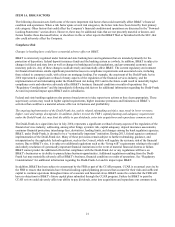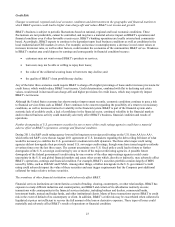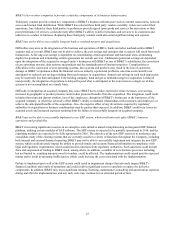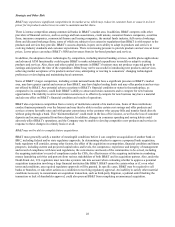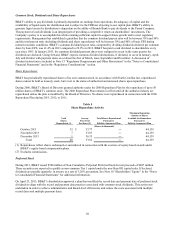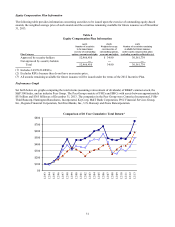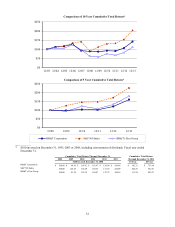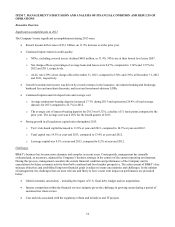BB&T 2013 Annual Report Download - page 27
Download and view the complete annual report
Please find page 27 of the 2013 BB&T annual report below. You can navigate through the pages in the report by either clicking on the pages listed below, or by using the keyword search tool below to find specific information within the annual report.27
BB&T relies on other companies to provide certain key components of its business infrastructure.
Third party vendors provide certain key components of BB&T’s business infrastructure such as internet connections, network
access and mutual fund distribution. While BB&T has selected these third party vendors carefully, it does not control their
operations. Any failure by these third parties to perform or provide agreed upon goods and services for any reason or their
poor performance of services, could adversely affect BB&T’s ability to deliver products and services to its customers and
otherwise to conduct its business. Replacing these third party vendors could also entail significant delay and expense.
BB&T may not be able to successfully integrate bank or nonbank mergers and acquisitions.
Difficulties may arise in the integration of the business and operations of BHCs, banks and other nonbank entities BB&T
acquires and, as a result, BB&T may not be able to achieve the cost savings and synergies that it expects will result from such
transactions. Achieving cost savings is dependent on consolidating certain operational and functional areas, eliminating
duplicative positions and terminating certain agreements for outside services. Additional operational savings are dependent
upon the integration of the acquired or merged entity’s businesses with BB&T or one of BB&T’s subsidiaries, the conversion
of core operating systems, data systems and products and the standardization of business practices. Complications or
difficulties in the conversion of core operating systems, data systems and products may result in the loss of customers,
damage to BB&T’s reputation within the financial services industry, operational problems, one-time costs currently not
anticipated or reduced cost savings resulting from such mergers or acquisitions. Annual cost savings in each such transaction
may be materially less than anticipated if the holding company, bank merger or nonbank merger or acquisition is delayed
unexpectedly, the integration of operations is delayed beyond what is anticipated or the conversion to a single set of data
systems is not accomplished on a timely basis.
Difficulty in integrating an acquired company may cause BB&T not to realize expected revenue increases, cost savings,
increases in geographic or product presence and/or other projected benefits from the acquisition. The integration could result
in higher than expected deposit attrition, loss of key employees, disruption of BB&T’s businesses or the businesses of the
acquired company, or otherwise adversely affect BB&T’s ability to maintain relationships with customers and employees or
achieve the anticipated benefits of the acquisition. Also, the negative effect of any divestitures required by regulatory
authorities in acquisitions or business combinations may be greater than expected. In addition, BB&T could incur losses on
acquired assets and increased expenses resulting from the failure to successfully integrate an acquired company.
BB&T may not be able to successfully implement a new ERP system, which could adversely affect BB&T’s business
operations and profitability.
BB&T is investing significant resources in an enterprise-wide initiative aimed at implementing an integrated ERP financial
platform, utilizing certain modules of SAP software. The ERP system is expected to be partially operational in 2014, and the
remaining modules are expected to be fully operational in 2016. The objective of the new ERP system is to modernize and
consolidate many of the existing systems that are currently used for a variety of functions throughout the Company, including
both internal and external financial reporting. BB&T may not be able to successfully implement and integrate the new ERP
system, which could adversely impact the ability to provide timely and accurate financial information in compliance with
legal and regulatory requirements, which could result in sanctions from regulatory authorities. Such sanctions could include
fines and suspension of trading in BB&T stock, among others. In addition, a number of core business processes including,
but not limited to, remitting amounts owed to vendors, could be affected. The implementation could extend past the expected
timing and/or result in operating inefficiencies, which could increase the costs associated with the implementation.
Failure to implement part or all of the ERP system could result in impairment charges that adversely impact BB&T’s
financial condition and results of operations and could result in significant costs to remediate or replace the defective
components. In addition, BB&T may incur significant training, licensing, maintenance, consulting and amortization expenses
during and after the implementation, and any such costs may continue for an extended period of time.






